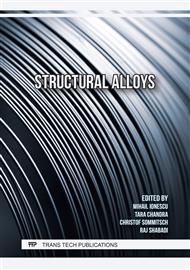p.3
p.11
p.19
p.25
p.31
p.37
p.47
p.53
p.59
Manufacturing Method and Thermal Properties of Open-Cell Type Aluminum Foam by Replication Casting Process
Abstract:
Open-cell type aluminum foam possesses unique structural characteristics comprising numerous interconnected pores within. This intriguing structure facilitates the passage of fluids (gas or liquid) through the interior of the open-cell type aluminum foams, enabling easy transfer to the exterior. The objective of this study is to manufacture open-cell type aluminum foams with varying pore sizes using the replication casting process and to evaluate their thermal properties. The equipment designed for the production of open-cell type aluminum foams consists of a chamber and an inner container. The chamber is connected to a vacuum line and an Ar gas line, with the container positioned inside. The aluminum alloys utilized for the foams were A356 and ADC12, and Na2CO3 served as the space holder. As a result of manufacturing the foams, there was no significant difference of porosity with space holder size and alloy types, the porosity averaged around 62%. To investigate the thermal properties of open-cell type aluminum foams in relation to pore size and alloy types, temperature variations were measured during sample heating via the hot plate method. Consequently, it was confirmed that the thermal properties of the foams were influenced by the structural conditions and alloy types.
Info:
Periodical:
Pages:
31-36
Citation:
Online since:
December 2023
Authors:
Keywords:
Price:
Сopyright:
© 2023 Trans Tech Publications Ltd. All Rights Reserved
Share:
Citation:



